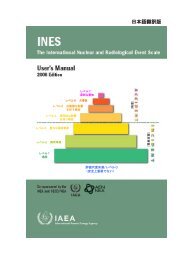Guidelines for Iodine Prophylaxis following Nuclear Accidents
Iodine_Prophylaxis_guide
Iodine_Prophylaxis_guide
Create successful ePaper yourself
Turn your PDF publications into a flip-book with our unique Google optimized e-Paper software.
<strong>Guidelines</strong> <strong>for</strong> iodine prophylaxis <strong>following</strong> nuclear accidents1999 updateit may provide and any possible anxiety it may create among thepopulation.4.2 Balance between risk and benefit of taking stableiodineThe lifetime cancer risk <strong>for</strong> exposed children can be taken to be1%/Gy (see section 2.4) and the risk of severe side effects from asingle administration of stable iodine to be 10 -7 . Accordingly, a riskequals benefit analysis (ignoring other factors) in averting doses assmall as 0.01 mGy. In practice, this means that the risk of severe sideeffects can be ignored when deciding on the intervention level. Minorside effects from stable iodine prophylaxis, such as skin rash orgastrointestinal complaint, constitute no major problem.On assuming a severe accident and applying the risk estimates <strong>for</strong>children cited in section 2.4 and the generic intervention level of 100mGy, without regard to age group, the incidence of thyroid canceramong those most exposed might be of the order of 20–50 per millionchildren per year. This is to be seen against the background ofspontaneous childhood thyroid cancer of about 1 case per millionchildren per year. The corresponding lifetime risk would be 0.1–0.3%<strong>for</strong> all children and even more <strong>for</strong> small children of the most sensitiveage. On the other hand, applying an age-specific intervention level of10 mGy radiation dose to the thyroid, the incidence of thyroid canceramong those most exposed might be some 2–5 extra cases per millionchildren per year, still a several fold increase compared to thegenerally encountered background incidence. The correspondingindividual lifetime risk would be of the order of 1–3×10 -4 .In view of the established relatively high risk of thyroid cancer amongthose exposed in childhood, planning <strong>for</strong> stable iodine prophylaxis <strong>for</strong>children should ideally be considered at 1/10th of the genericintervention level, that is at 10 mGy avertable dose to the thyroid. Thislevel is also appropriate <strong>for</strong> pregnant women.Even if an avertable dose were grossly overestimated in a realemergency, no significant health hazard would result from stableiodine administration.14






